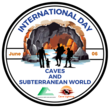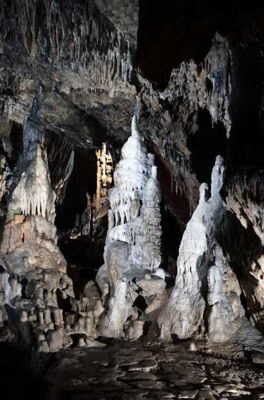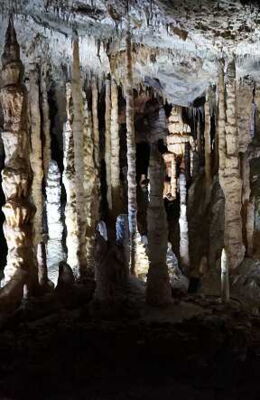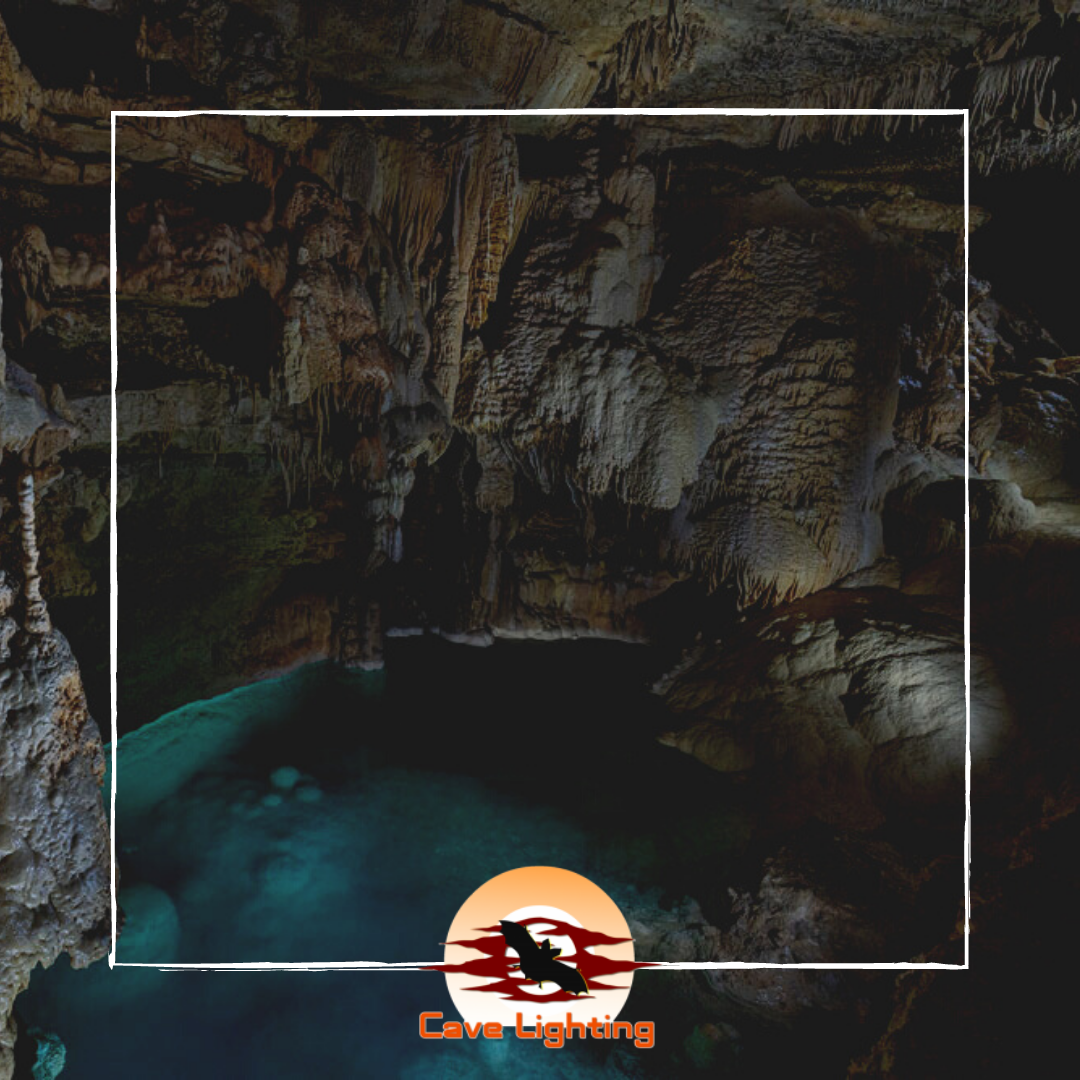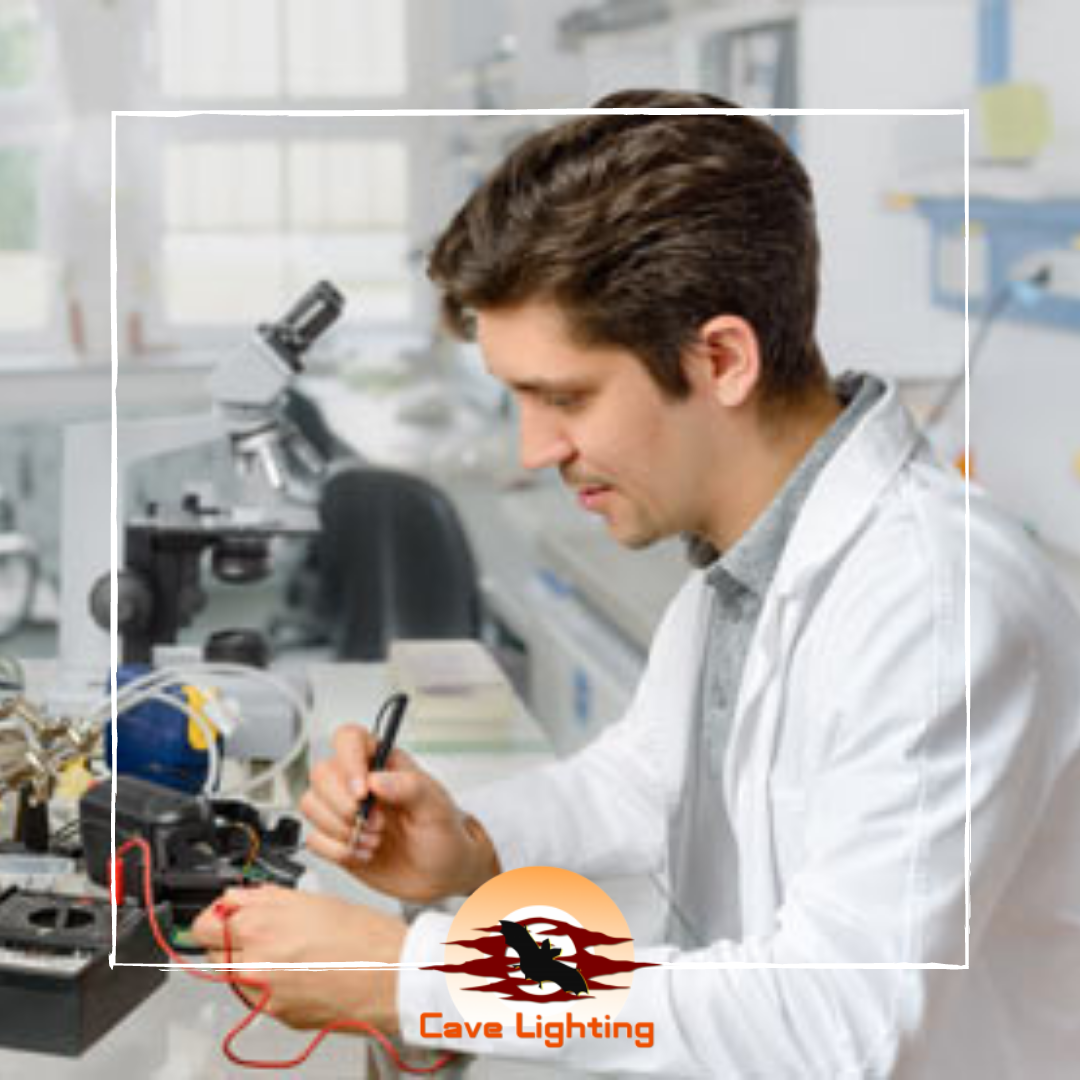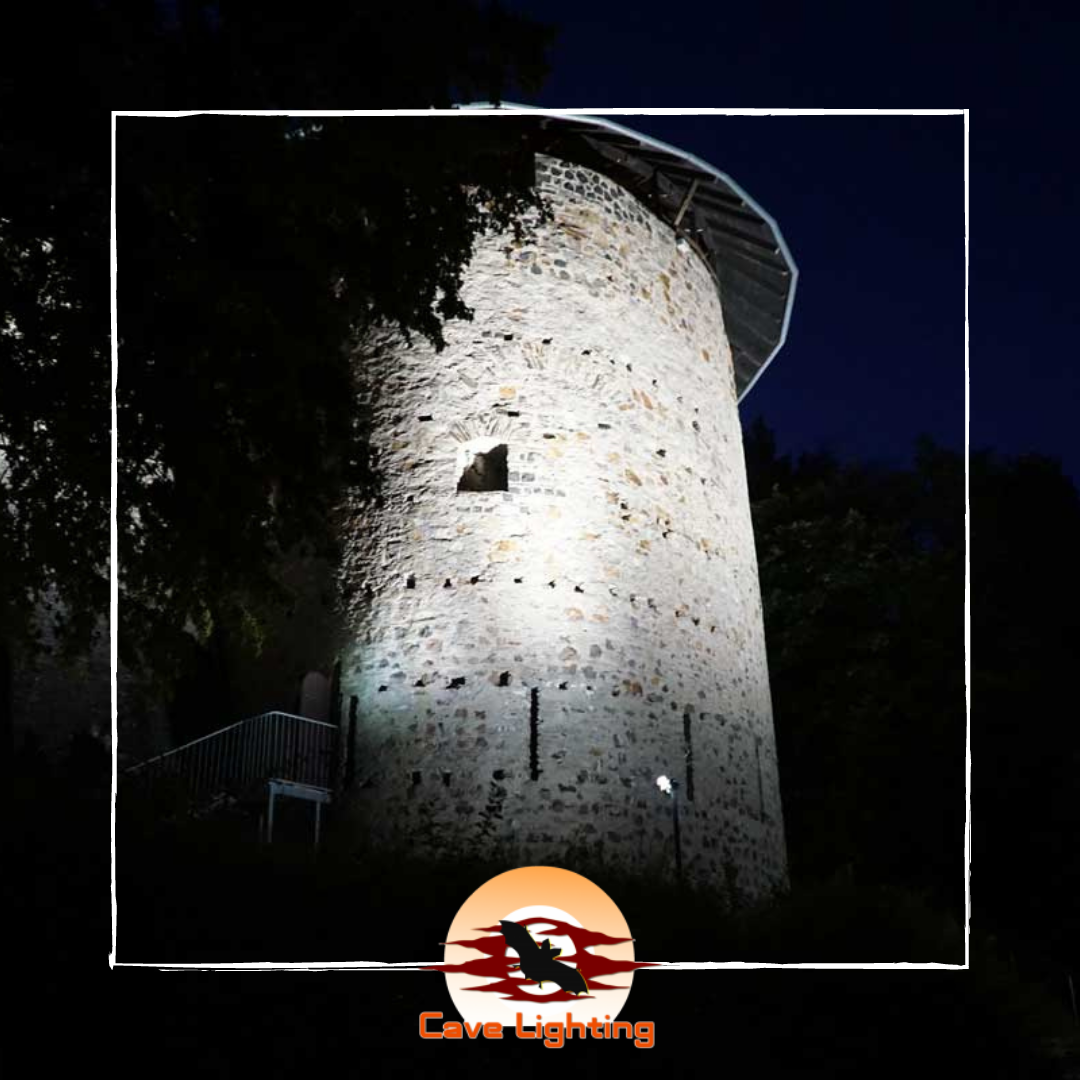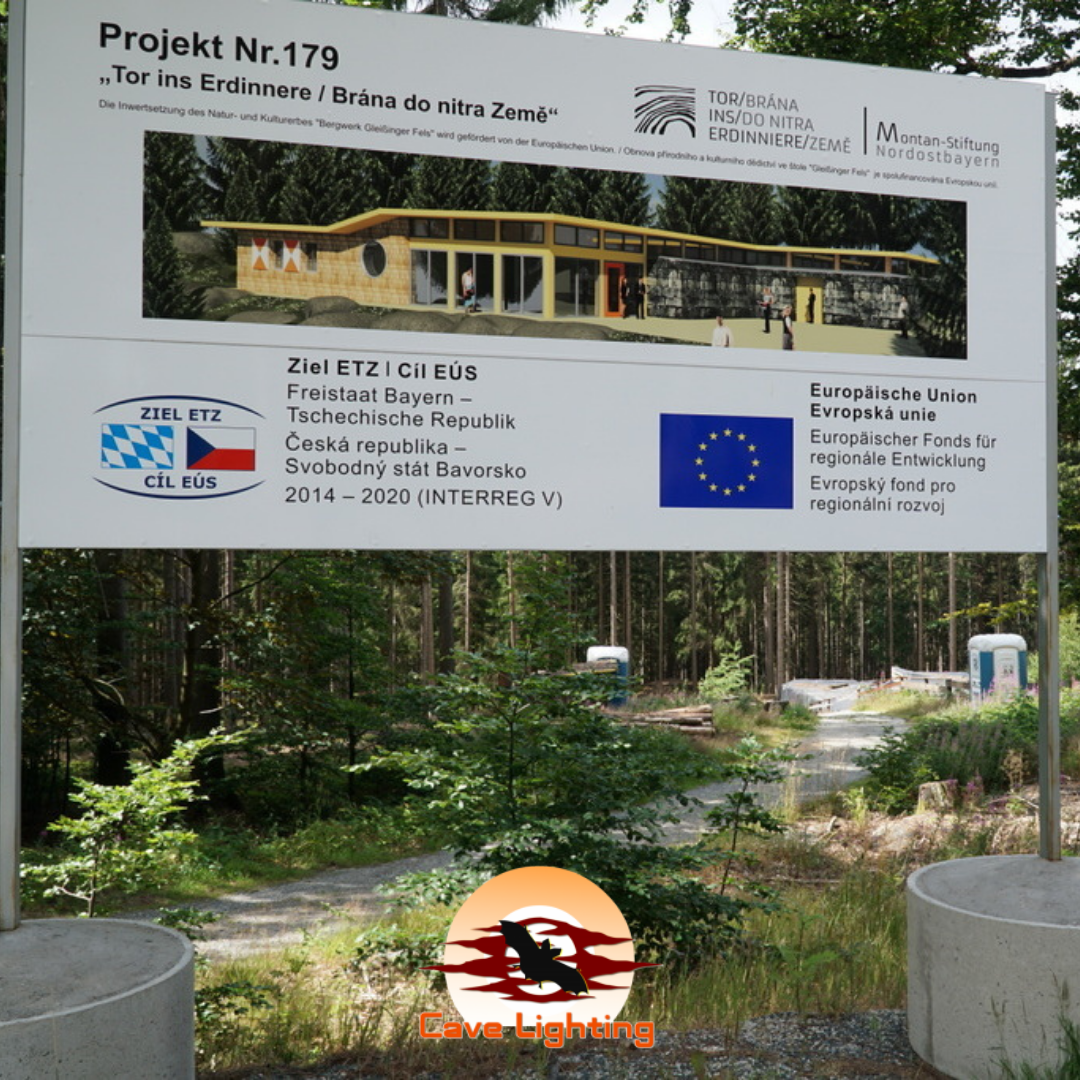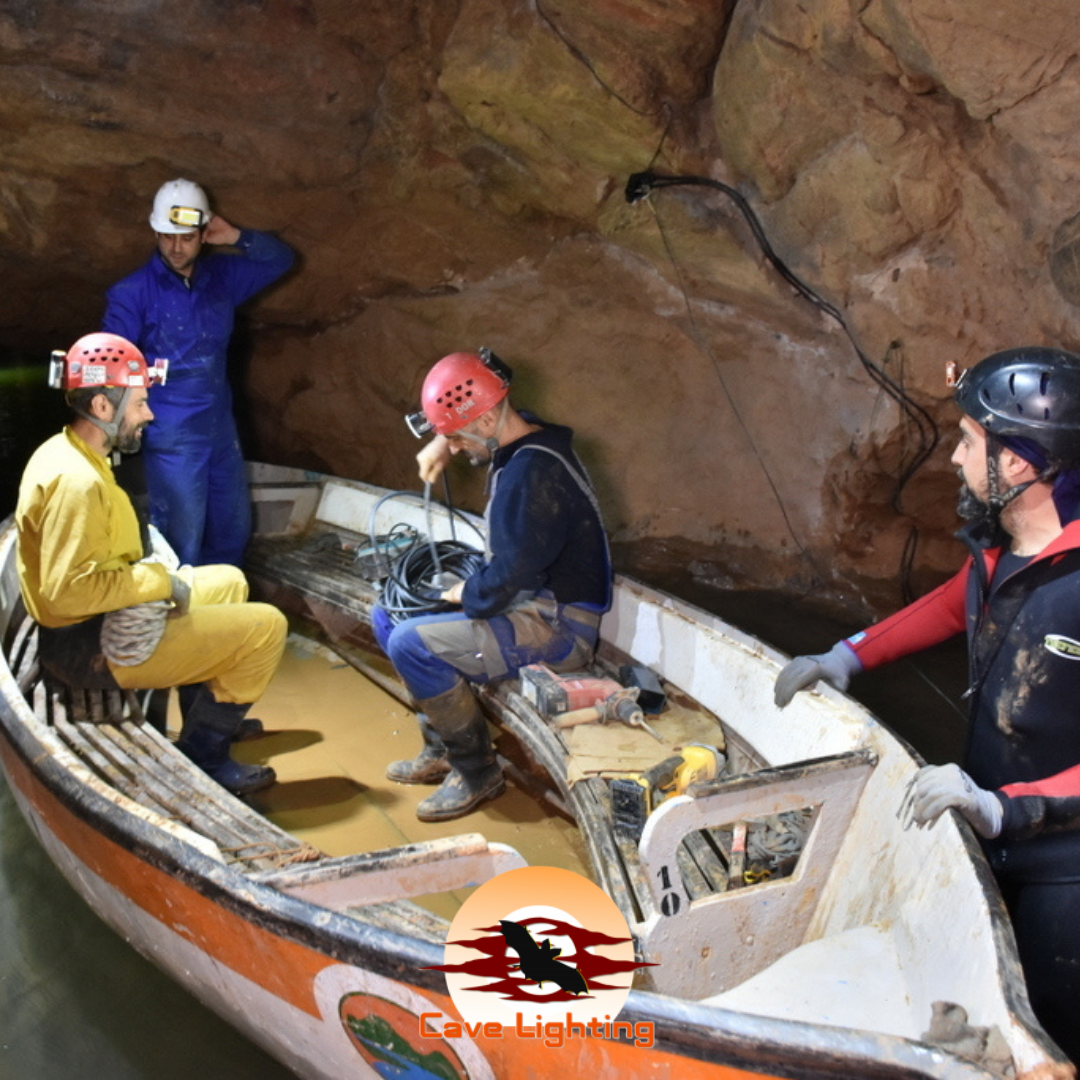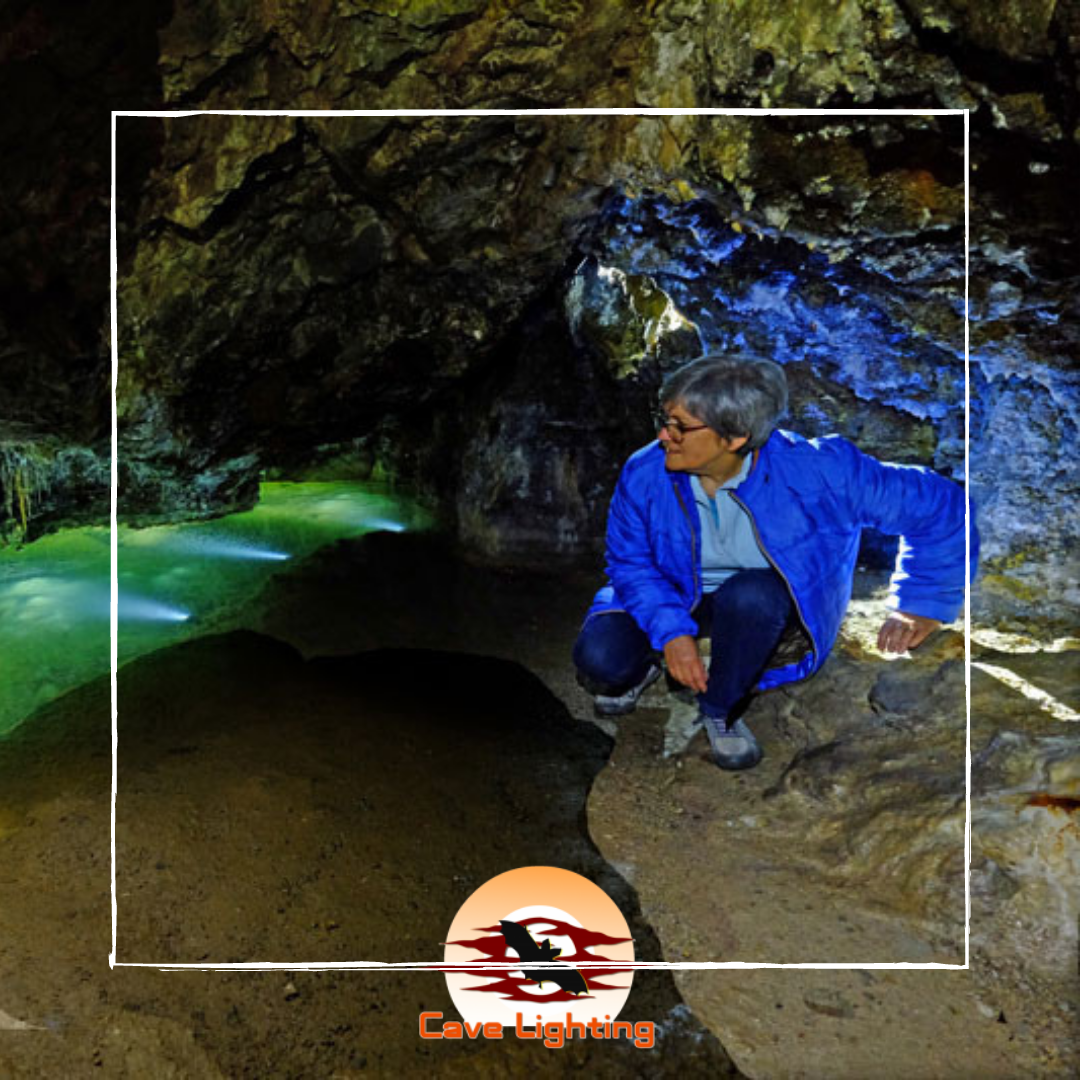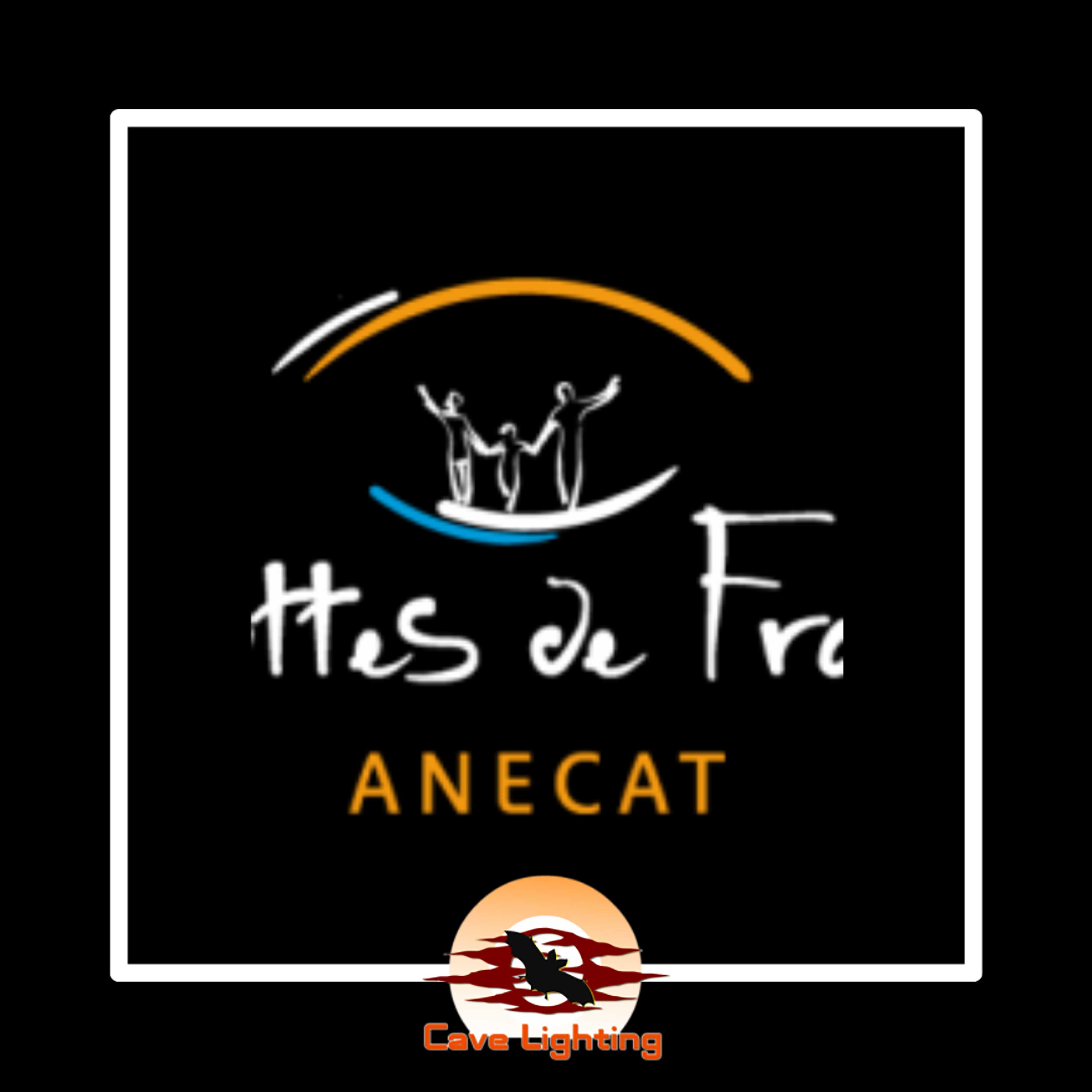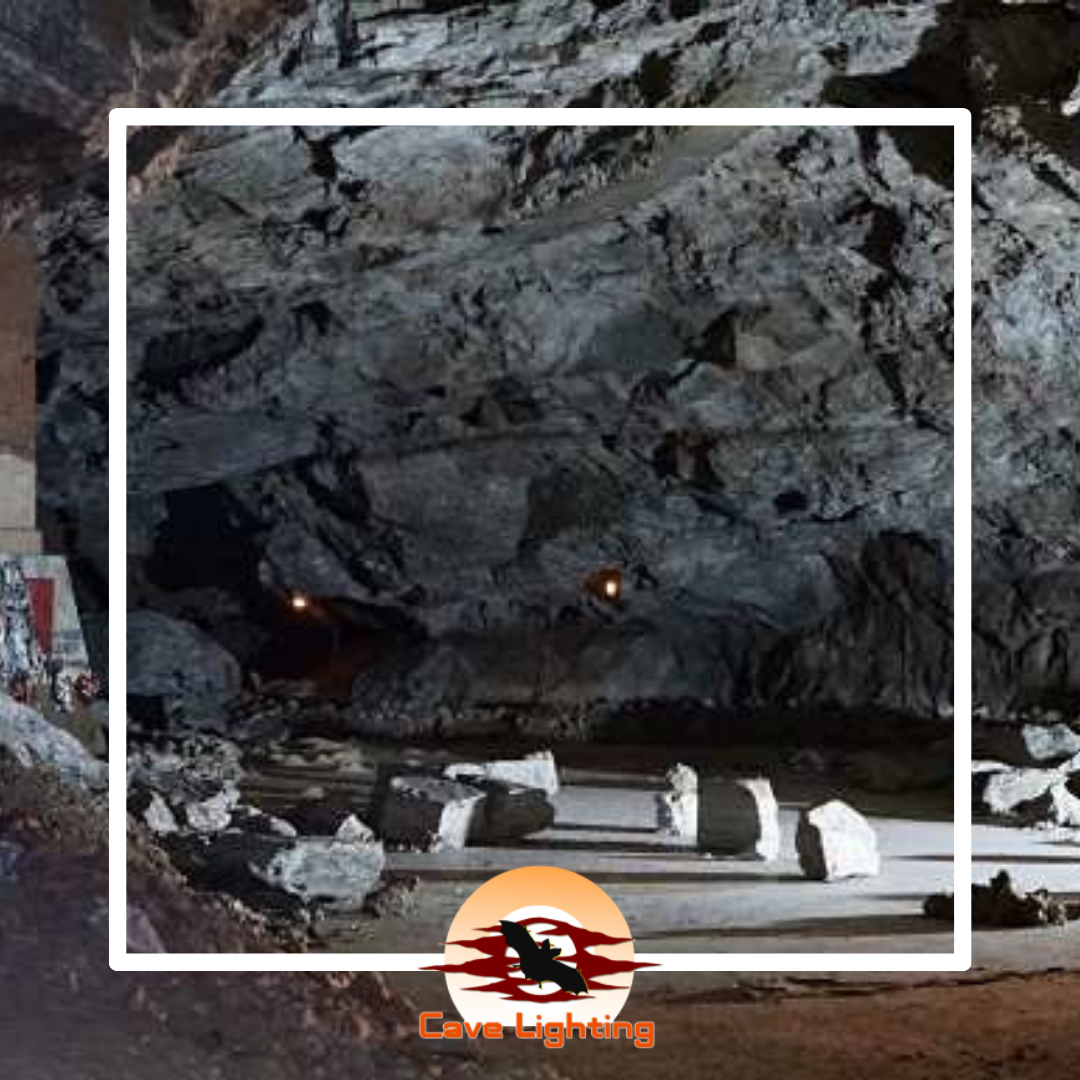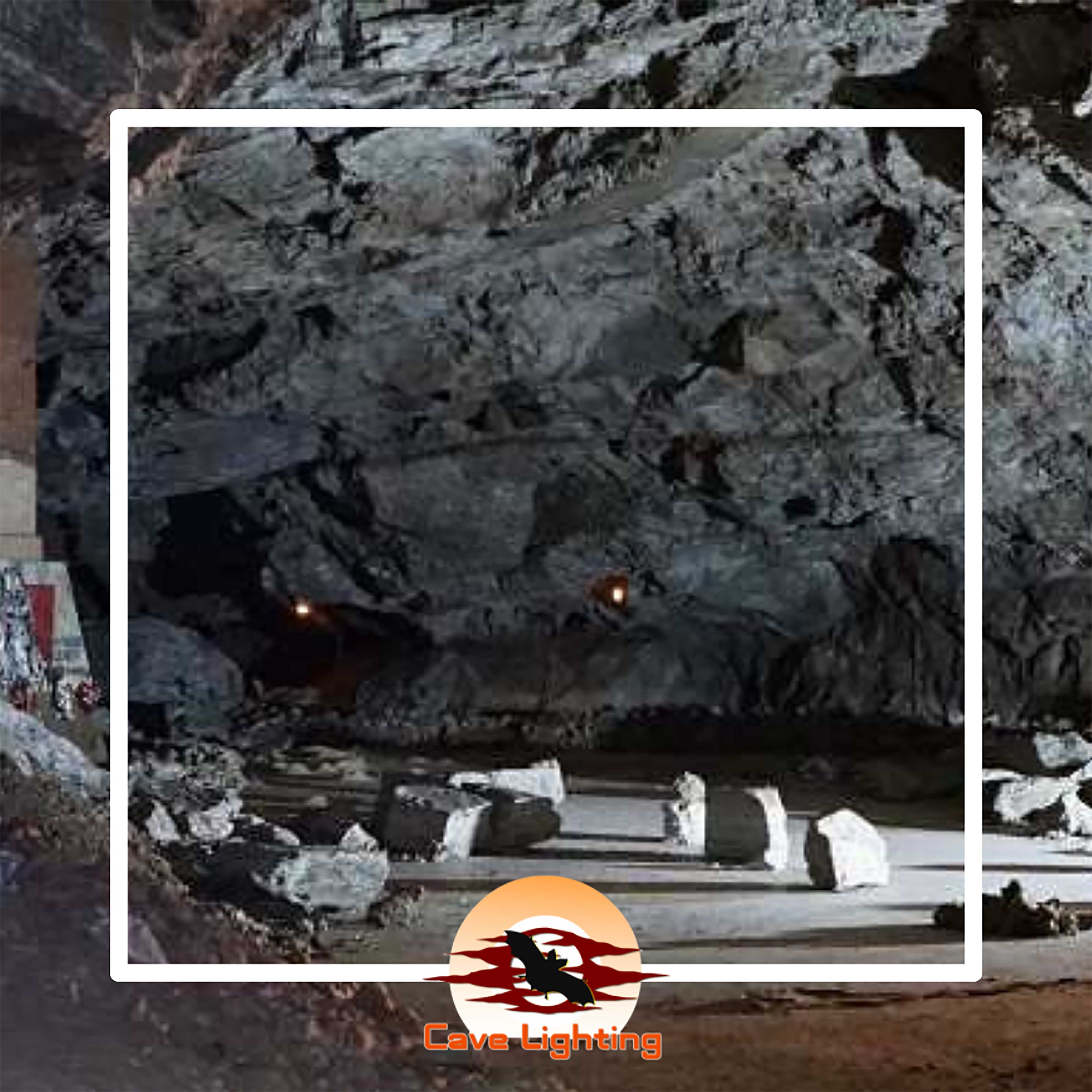
Magazin “ACKMA”
Report von Greg Middleton über CaveLighting im australischen Magazin "ACKMA"
Nachfolgend können Sie den Original Beitrag von Greg Middleton in dem australischen ACKMA Magazin (März 2019) in englischer Fassung lesen.
ACKMA Journal No. 114 March 2019
Cave Lighting Workshop, Grottes de Han, Belgium, Nov 2017
Greg Middleton
When I heard that the German firm, Cave Lighting GmbH, was going to host a cave lighting expo or workshop at Grottes de Han in Belgium, I thought it would be interesting to attend. Belgium, however, seemed a long way to go for a three day event. When I mentioned to an old colleague, Prof. Stephan Kempe, that I was having trouble justifying the trip, he invited me on a tour of caves in northern Germany beforehand. This settled the matter and I arrived at Hamburg, on 31 October, to be met by Stephan and his wife Christhild.
Segeberger (or Kalkberg) Höhle
Our first cave was Segeberger (or Kalkberg) Höhle, with its associated bat museum, Noctalis, in the town of Bad Segeberg. This is the most northerly karst cave in Germany, the second-longest cave in anhydrite (a labyrinth totalling ~2,000 m) and the only show cave in the state of Schleswig-Holstein. It has formed in an isolated outcrop of anhydrite underlying gypsum (‘kalkberg’ means ‘limestone mountain’), raised by a salt dome and surrounded by moraines and other glacial deposits.
Anhydrite is unhydrated calcium sulphate, while gypsum is the hydrated form. If water is present anhydrite can absorb it and recrystalise to gypsum. Anhydrite is often found associated with salt deposits as the salt tends to absorb groundwater, protecting the anhydrite.
Quarrying of the ‘berg’ has been underway for centuries. The castle that once stood on the summit is long gone.
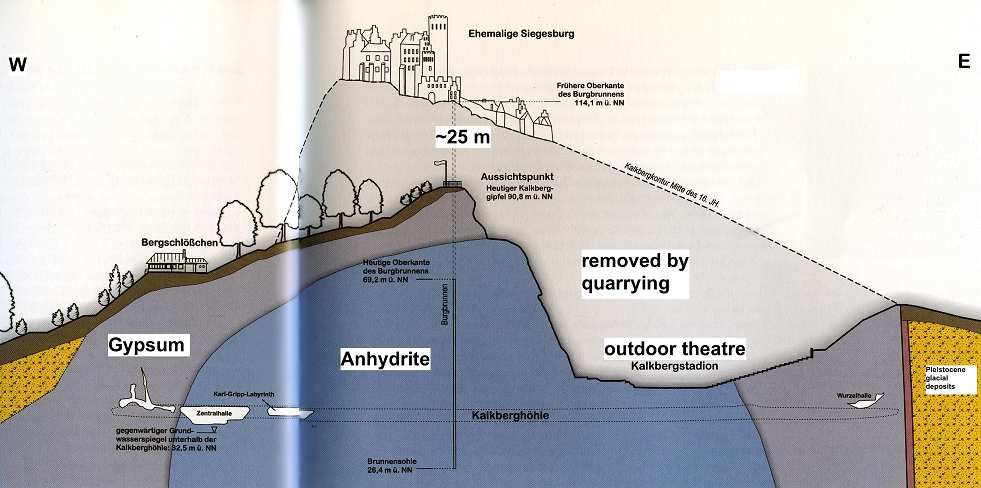
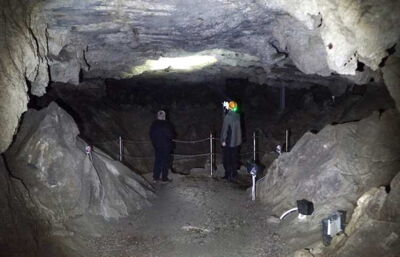
The cave was discovered in 1913 when quarrying broke through the roof. Within a year it was opened to the public. Quarrying ceased years ago and the quarry is now occupied by an outdoor theatre. Although the cave is closed to the public from 1 October for bat hibernation (about 20,000 bats hibernate here; 8 species are represented), Dr Anna Ipsen, the site manager, needed to carry out a check of the cave and the bats so she invited us to join her. We followed approximately the tourist route (but without the lights). Although, typically, anhydrite flakes (as at Barbarossah.hle, about 380 km to the south), here the mineral does not flake off the walls. Nevertheless, there is a deal of concern about possible collapse and some parts of the cave are no longer included on the tour. Gauges have been fitted at strategic locations to provide early warning in the event of any movements. Passages were formed under an older, higher water table by solution, typically resulting in remarkably flat ceilings and inwardsloping walls, forming triangular cross-sections.
As is typical of caves in anhydrite, there are none of the speleothems one expects in caves in carbonates. In recent years, the cave has been lit with LEDs by Cave Lighting but, unusually, no attempt has been made to hide or disguise the lights and there are no separate track lights. The lighting appears to be adequate and functional, if unnecessarily obvious. After the cave, we did a tour of the excellent bat museum which includes a ‘nocturnal house’ featuring (tropical!) micro-fruit bats.
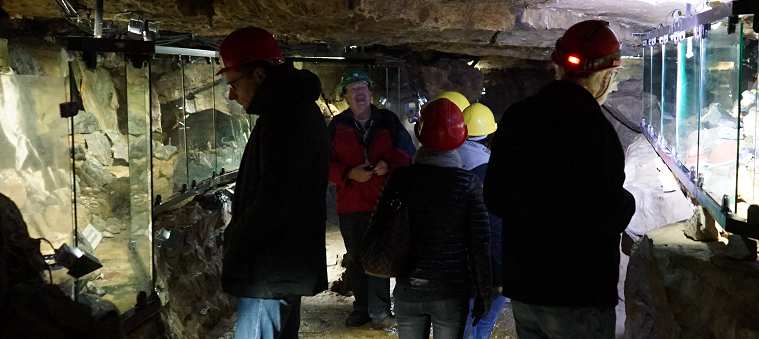
Schillathöhle
The second cave was the Schillathöhle near Hessisch Oldendorf. There we watched a 3D nature film (which did not relate to the cave) before descending to the cave in a lift. This is a relatively new show cave, having been opened in 2002.
The Schillathöhle is on the side of what has been a quarry in Upper Jurassic limestone. The lift drops 45 m just behind the quarry face; at the bottom, a tunnel takes visitors out into the quarry itself where we were told something of the local geology. The tunnel, partly concrete-lined and adorned with copies of ancient cave paintings, is then followed back to the cave, which is claimed to be 180 m long. It is difficult to tell how much of the ‘cave’ has been excavated and how much is natural. There are lots of rock specimens, fossils, minerals and speleothems in glass cases lining both sides of the path – but in situ speleothems are almost nonexistent.
he lighting is by (Cave Lighting) LEDs but it is not progressively switched, resulting in rampant lampenflora. To top off this most underwhelming of cave tours, at the conclusion the visitor is admitted to a theatre excavated at the end of the cave and shown a 3D slide-show of another cave altogether, the Riesenberg Höhle. The photographer who produced the show is one David Stucky of Sydney!
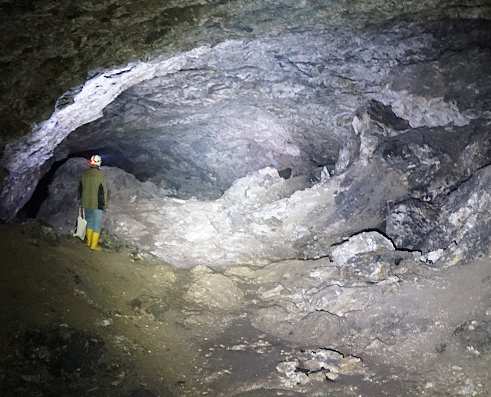
Jettenhöhle
Our third cave was Jettenhöhle in the Hainholz Nature Reserve in the Harz Mountains, south-east of Hannover. To reach this wild cave, we walked well-made trails (the ‘Karstwanderweg’) which wound between innumerable ‘erdfälle’ in very pleasant forest. Erdfälle are collapse sinkholes – the result of collapse into a natural cavity formed by solution. In the southern Harz region there are around 20,000 of them. They started forming after the last ice age, about 11,000 years ago Jettenhöhle (first recorded in 1308 – it is the oldest cave name in Germany) is a typical cave in gypsum. While it has no speleothems, it has interesting passage shapes resulting from gradual breakdown of the roof (fresh chunks were evident on the floor), large pools of clear water and calcium sulphate crystals on the walls.
The pools result from upwelling (hypogene) groundwater from carbonate aquifers below and are not saturated with gypsum (Kempe and others 2017, pp. 13-14).
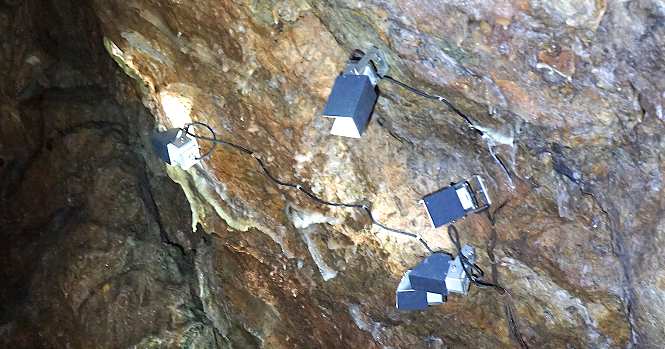
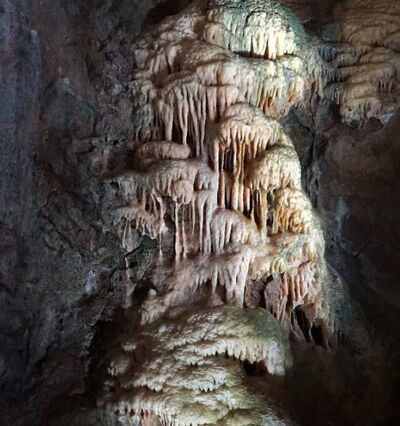
Iberger Tropfsteinhöhle
Later that day, we visited the Iberger Tropfsteinhöhle (Iberg Dripstone Cave), a long-established show cave (opened 1874), in Upper Devonian limestone, near Bad Grund. As Kempe (1997) explains, the nature of this cave’s formation is quite unusual: the CO2 required for dissolution of the limestone does not come from the overlying soil – as is usual in the formation of limestone caves – but is a by-product of siderite (iron carbonate) weathering in the cave itself. Siderite decomposes in aerated groundwater to form goethite and then iron oxide (limonite). The released CO2 attacks the limestone around the former ore body and creates irregular cavities. The cave is now accessed through a long tunnel which slopes up from the visitor centre/museum. This has been constructed so visitors can reach the cave in comfort, even when it is raining or snowing. The walls of the tunnel are covered with displays and information about the cave and its environment. Our guide, Sylvia, took us on a tour although the cave was officially closed. The cave has also been lit by Cave Lighting and again, perhaps strangely, no attempt has been made to hide the LED lights, though all are hooded.
In one section blue and green lights were meant to simulate an underwater scene (back when the area was a coral reef) but one blue light stays on when the normal white ones are lit – presumably a wiring glitch. Some use was made of tracklights, which were generally hidden. Lampenflora is a serious problem – probably because lights are left on too long. Despite its name, the cave is not heavily festooned with speleothems, though there are good examples.
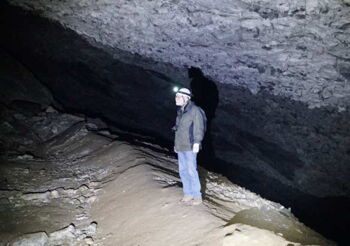
Himmelreichhöhle
Near Walkenried, Stephan and I walked along a railway line to the Walkenrieder Tunnel. About half way through the 270 m tunnel, we came to a side tunnel which, after a few metres, ceased to be lined with bricks and opened into an anhydrite cave – the Himmelreichhöhle (Kingdom of Heaven Cave). The railway tunnel provides the only access to this wild cave. According to the brief Wikipedia entry, the cave is 170 m in length, up to 85 m in width and has a ceiling height up to 15 m. This makes it one of the largest cavities in Germany (Kempe & Bauer 2017). What makes this cave really different is that it was discovered on 9 July 1868 when it was broken into by those excavating the railway tunnel. Undeterred, they built a section of the tunnel inside the cave, lined it with bricks like the rest of the tunnel and covered it with fill. We had to climb steeply up over material which had been brought in to cushion the top of the tunnel.
The large chamber reverberated with a strange rumble whenever a train passed through the tunnel below us. We walked to the end of the chamber with anhydrite peeling off the ceiling and in chunks all over the floor. At the end was a small tunnel dug to provide access from the surface, through which the fill was brought in; it is now sealed. From a low point in the chamber, we followed another small tunnel dug to drain water away from the anhydrite.
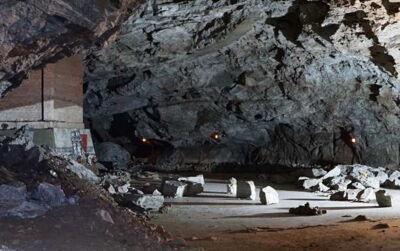
Schauhöhle Heimkehle
Near Uftrungen, we visited our sixth cave, Heimkehle show cave. Rainer Völker, an old friend of Stephan’s, guided us on a tour of the cave which is only open to the public in November and December and then only on Friday, Saturday and Sunday. This cave is the largest German show cave and the only one entirely in gypsum (Kempe 1997 pp. 89-90). It has an interesting history dating back to at least 1357 when it was first recorded. It was visited by the Prince of Anhalt in 1649 but it was only properly developed as a show cave in 1920 when Theodor Wienrich installed pathways and electric lighting. During World War II, the Nazis turned it into a bombproof production site for Junkers aircraft. Forced labour was used. Due to the bad conditions and harsh treatment, many workers died. In 1946, the Allies blew up the access tunnels but, in 1953, new tunnels were dug to reopen the show cave. In the chamber known as the Small Cathedral (Kleiner Dom), where the original lake had been concreted over and production facilities set up, East German authorities built a memorial to the concentration camp inmates.
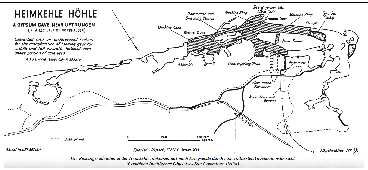
In the Great Cathedral (Gro.er Dom) – 40 to 60 m in diameter and 25 m high – also a major production site, a laser lightshow was installed in 1990.
We entered through a long tunnel, along the walls of which were excellent interpretive displays of the history of the site and its natural history/geology (prepared by our guide). Walking through the cave, one is greatly impressed by the size of the large chambers – first the Kleiner Dom where only the concrete floor and some brick walls remain from the aircraft factory – and then the larger Grosser Dom. The concrete floor clearly shows the large blocks which have fallen from the roof since WWII. This process continues. Further on we were shown a natural lake with underwater lighting.
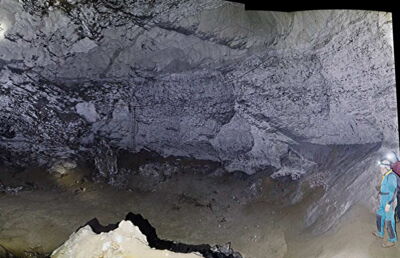
Wimmelburger Schlotten
Next day, we drove to Wimmelburg, near Lutherstadt Eisleben, to visit the Wimmelburger Schlotten, one of the largest anhydrite caves in Europe. This can only be accessed through an ancient mineshaft which is still maintained. This entranceless cave was filled with water until drained by the miners. Stephan had evidently pulled quite a few strings in order to gain us access to this extraordinary cave (one not open to the general public). On the gate, as we entered, was a sign (in German) which read: “W-Shaft. Water lifting and escape shaft, used for weather management and water supply. Constructed 1811-15, reaching its final depth 1882. Depth: 130 m.” We were welcomed by the local staff who maintain the mine and associated equipment, particularly the water and drainage works. It was explained that the mine had begun operations in the late 18th century, exploiting a copper-shale ore which exists in a thin bed below anhydrites/gypsum and limestone. We were shown the ancient machinery which still provides access to the mine – and the anhydrite caves it broke into – primarily to allow the drainage works to be maintained. We descended the 1811-15 Shaft W for about 100 m in an ancient two-person mine cage, then walked through a series of passages, tunnels and chambers. We saw waterworks which supply local towns with water; passages adorned with speleothems; places where collapses have occurred; where ore was mined and numerous walls covered in the names of miners or visitors. A highlight was the large ‘Dancing Hall’ (Tanz-Halle), where miners’ parties and entertainment were traditionally provided.
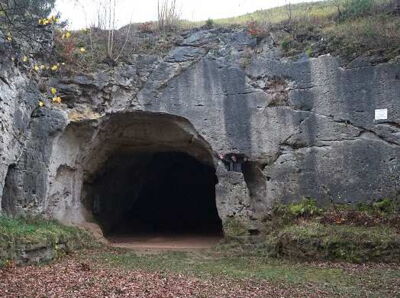
To complete the day, we stopped to visit the Steinkirche (’Stone Church’) near Herzberg – a large open cave in dolomite – heavily modified for religious gatherings in ancient times. It is a round-arched cave, about 28 m long, 6 to 8 m high and of similar width. In the Paleolithic, the cave was used by reindeer hunters for shelter. In the Middle Ages, it became a church with a cemetery in the forecourt. It was abandoned about the 16th century.
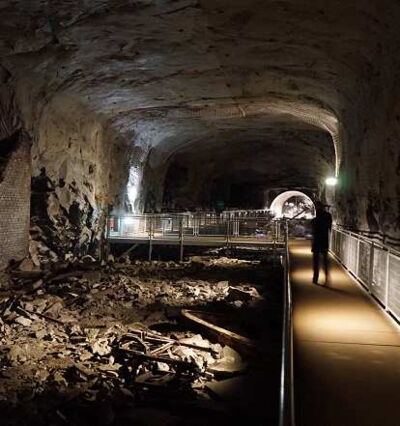
Einhornhöhle (Unicorn Cave)
Our first stop next morning was the nearby Einhornh.hle (Unicorn Cave), which features a “unicorn” statue. It is a show cave but was closed for the winter. First documented in 1541, it was visited by Gottfried Leibniz, German polymath and philosopher in 1686. He reported that bones from the cave were being sold as unicorn fossils and he reproduced a reconstruction of the skeleton of the fictional animal. Only in 1872 did Rudolf Virchow carry out an excavation and identify the bones as coming from mammoths, cave bears, cave lions and wolves. We then drove on to the site of the Mittelbau-Dora concentration camp just north of Nordhausen, Thuringia. In World War II, the Nazis established a subterranean fuel depot in excavated tunnels under Kohnstein mountain. Slave labour was then used to extend greatly the tunnel system for the manufacture of V-2 rockets. In April 1945, the Dora camp was liberated by American troops then passed to Soviet control in July. In 1947, the entrances and some internal parts were blown up in accordance with the Allied agreement to destroy military facilities in Germany. Following German reunification in 1990, parts of the tunnel system were reopened in 1995 and made accessible to visitors by opening new access tunnels. We joined a guided tour of a small part of the tunnels, which were quite remarkable.
Hermannshöhle
We then drove north to the village of Rübeland to visit one of two show caves in the town, Hermannshöhle. The other show cave, Baumannshöhle, was closed for winter. A guide took us on an excellent tour which was conducted in German, with translation by Stephan. The lighting was adequate to good. Some lampenflora is growing around new LEDs, even though they are not left on continuously. This is a remarkably well decorated cave – but, sadly, photography is strictly verboten! There is a small but informative display (in German) in the ticket office. Next day, we drove north across the Harz Mountains to near Goslar, to inspect the World Heritage listed “Bergwerk Rammelsberg”, ‘show mine’ and museum. We joined a tour of accessible parts of the old mine, highlights of which were the huge wooden water wheels that were used to lift the ore and pump water out of the mine. This ended a great trip with the Kempes.
The lighting conference
Next day, in Frankfurt, I joined up with the group going on a pre-workshop tour of Cave Lighting lit show caves. This comprised Tom Summers of Cave Without a Name, Texas; Mario Verole-Bozzello of Grotta del Vento, Italy; Fritz Oedl, of Eisriesenwelt, Austria; Brad Wuest, President of ISCA and owner of Natural Bridge Caverns, Texas, and two of his staff.
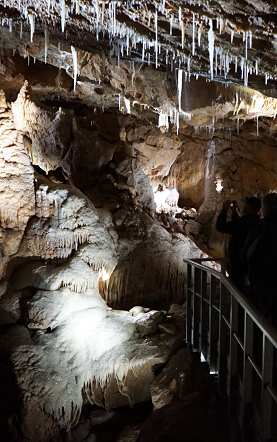
Pre-Workshop tour
Our first stop was Braunfels where we visited the Schloss Braunfels, a family castle dating back to at least 1246. There we met the current Count Oppersdorff Solms- Braunfels and his sons. The Count claims 21 generations of his family have lived here over the last 800 years! We were taken on a tour of the family heritage displays: a fabulous collection of guns and other weapons, clothes and uniforms, coins and medals, hats, furniture, paintings, etc, which must be of inestimable historical, not to mention material, value. The significance, for our purposes, was that the displays were (well) illuminated by Cave Lighting LEDs.
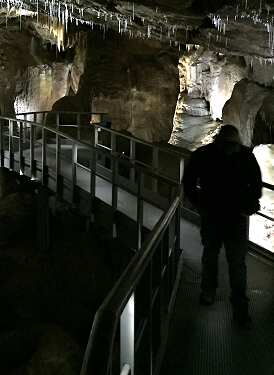
Our cave visits started with Schauhöhle Herbstlabyrinth (Autumn Labyrinth Show-cave) near Breitscheid. It was discovered by Alex Chrapko’s caving group in 1993, from the adjoining quarry. The Herbstlabyrinth-Adventhöhle system has a total length of 4.7 km, though only a part of this is shown. This was the first cave to be lit by Cave Lighting, in 2009, and the company appears to have done an extremely good job. The tour is mainly around the large Knöpfchenhalle chamber (50 m long, up to 22 m wide and 32 m high) which is entered via a tunnel descending from the visitor centre/gift shop. The lights are well placed and adequate to show the beautiful, mainly white, speleothems. The walkways are entirely of fibreglass reinforced plastic and show negligible wear and tear despite a decade of service.
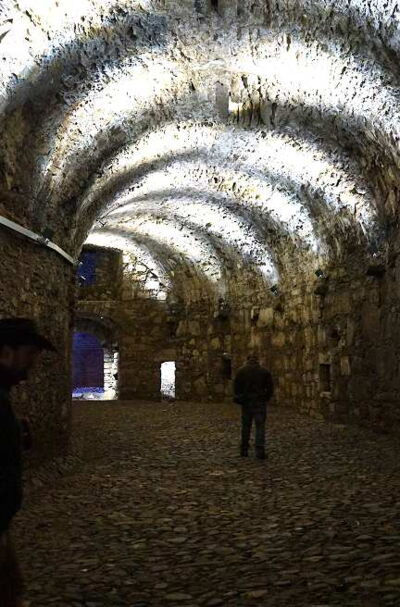
At Dillenburg, we visited the impressive Willhelmstrum monument (to Willhelm I of Nassau, aka William of Orange). The original structure on this site, built in 1130, was destroyed in 1760. The present tower was built in 1872. Our interest, however, was in the system of underground fortifications and communication tunnels beneath the building. The tunnels have, of course, been lit by Cave Lighting. They demonstrate some of the difficulties of lighting bare passages where there are no rocks or speleothems to help conceal the lights.
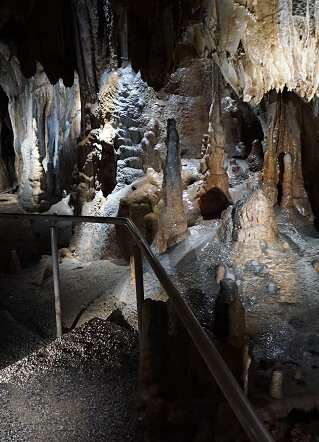
Next day we travelled by minibus to Iserlohn to visit the show cave Dechenhöhle, one of the most visited show caves in Germany (with more than 14 million visitors to date). The cave lies beside the Letmathe–Fr.ndenberg railway and was discovered by two railway workers in 1868. A station was built at the entrance and the cave was operated by the railway company until 1983 when it was taken over by a private company. We were introduced to the staff and taken on a tour of 360 m of the 870 m long cave. The cave is well decorated and has been nicely lit by Cave Lighting – except for a couple of places where coloured lights have been employed (and some fairly ordinary-sounding music is played).
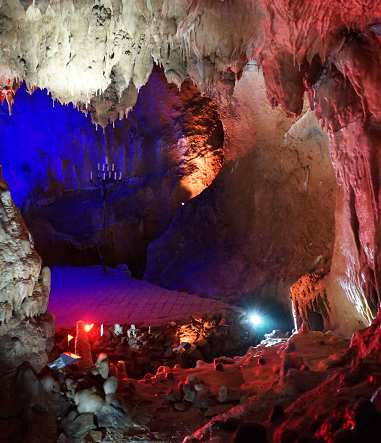
The cave is known for its rich fossil bone dig, mainly yielding cave bear. There is also a stage where small musical performances are held and a feature is made of some large barrels of whiskey which are maturing in the cellar-like environment. After the cave, we took a close look at the excellent museum which relates to both the Dechenhöhle and caves/speleology in general. It which had been curated by local cavers.
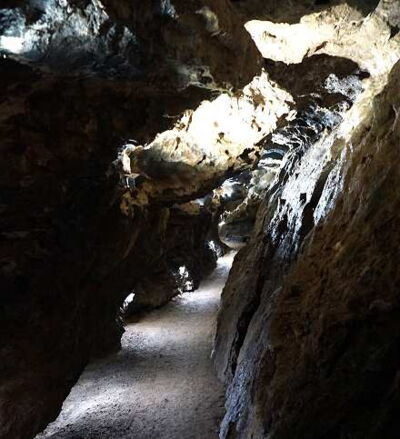
We were then driven to Ennepetal to visit the Klutherhöhle which is accessed from a small shopping centre by a footbridge over a major road. Klutherhöhle is unusual for a limestone cave in that, as Kempe (1997) has observed, “there are no speleothems to admire; they have long since been broken off.” Kempe also gives some historic details: the cave has been known since the Baroque, the earliest known inscription was dated 1649; the first known plan was prepared in 1785. But the cave was really ‘put on the map’ by an event on 19 November 1883. That day, forty-three year old Heinrich Schmidt entered the cave but “His candle burned down faster than he thought. Matches and scraps of paper were soon consumed, and in his rising panic, Schmidt tore off his shirt and burned half of it before finally being left in the dark” (Kempe 1997). After 7 days and 8 nights wandering in the cave, Schmidt found his way out. Despite his ordeal, he obtained permission from the owner of the cave to open it to the public; this occurred in May 1884. Electric lighting was provided on the 750 m tour in 1951. Recently the cave has been relit by Cave Lighting with LEDs. There are some coloured lights and use is made of recorded sounds, presumably to entertain visitors.
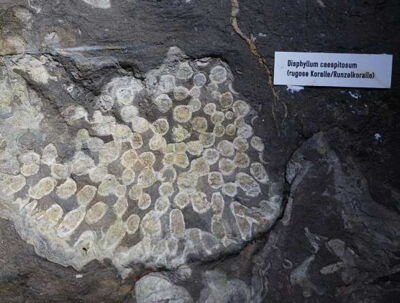
Although there are virtually no speleothems, the limestone is rich in fossils, especially of corals, and these are often evident on the walls, sometimes in distorted forms.
The cave is a remarkable maze, primarily of narrow, often high, passages which follow the limestone’s joint pattern. It has a surveyed length of 5.3 km, making it Germany’s fifth longest cave and, arguably, its best example of a complex labyrinth.
This concluded the pre-workshop caves tour. Next day we drove via Köln/Cologne to Han-sur-Lesse in Belgium for the cave lighting workshop.
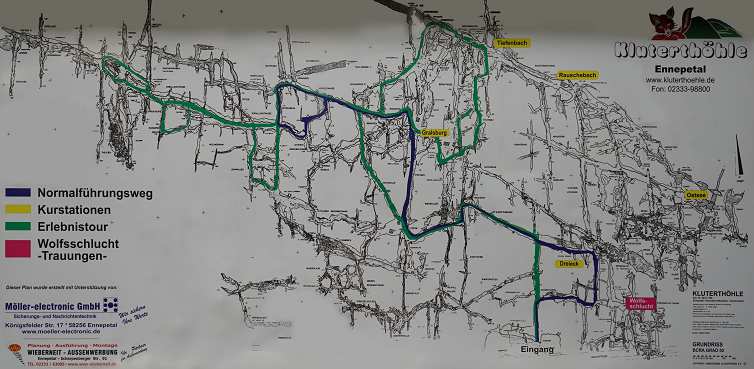
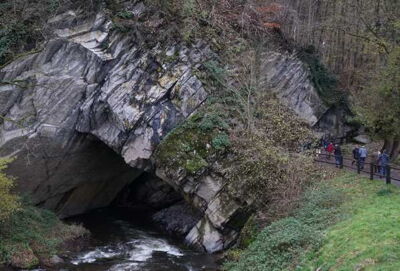
Cave Lighting Workshop
Cave Lighting GmbH was set up in 2006 by a group of cavers who had been unimpressed by the lighting they saw in a certain German show cave. They thought they could do better – they have! The company is headquartered in the village of Herborn, Germany, and is managed by Alexander Chrapko, assisted by a team including Adrian Kondacs (cave lighting specialist and project manager), Vladimir Vashkevich (technical manager, in charge of development and support) and others. The company not only assembles its own ‘luminaries’ (light fittings for those not part of the cognoscenti) but can provide a total cave development package, including walkways, platforms and stairs of fibreglass reinforced plastic. The cave lighting workshop, which also had the backing of ISCA and IUS, was held in Han-sur-Lesse, Belgium because Cave Lighting had just completed the re-lighting of the Grotte de Han and were keen to demonstrate what had been achieved (as was the cave management). There were to be around 80 participants, mainly from Europe and the US, (including those who participated in the preworkshop tour) but also including Don Haider from Dark Cave, Batu, Malaysia and Peter and Margaret Robertson of VSA/Buchan Caves. The formal proceedings, starting on 16 November, were conducted in the building housing the Grotte de Han museum, “PrehistoHan”, which we had the opportunity to visit before the workshop got underway. The museum contains very fine displays on numerous aspects of the cave, its history of discovery and exploration, and particularly the remarkable archaeological finds (mainly from the large pool at its entrance, now the exit from the cave tours). The first presentation, given by Alex Chrapko and Oliver Heil of Cave Lighting, “A new era in show cave illumination”, concentrated mainly on the range of LED lights which Cave Lighting has developed especially for illuminating caves and which have very high waterproof ratings. The Company won the contract to re-light the Grotte de Han completely , a project which had only just been completed. We were shortly to see the benefits. The next presentation, by Ewa Krywko and Brigitte Malou of Grotte de Han management, was entitled “Domaine of the Caves of Han – the integrated approach to cave management”, and told of the very hands-on management style of the cave operators. A third presentation showed how lasers could be used to create visual spectacles in show caves. (Whether these are necessary or even beneficial could be debated – and might depend on what else a particular cave has to offer.) After the first session we were all taken on a bus-train trip to the Grotte de Han, through the reserve’s extensive wildlife park where local fauna is displayed in large natural enclosures. We viewed the quite spectacular cave entrance, the Gouffre de Belvaux (or Belvaux Chasm) where the Lesse plunges into a 50 m deep sump.
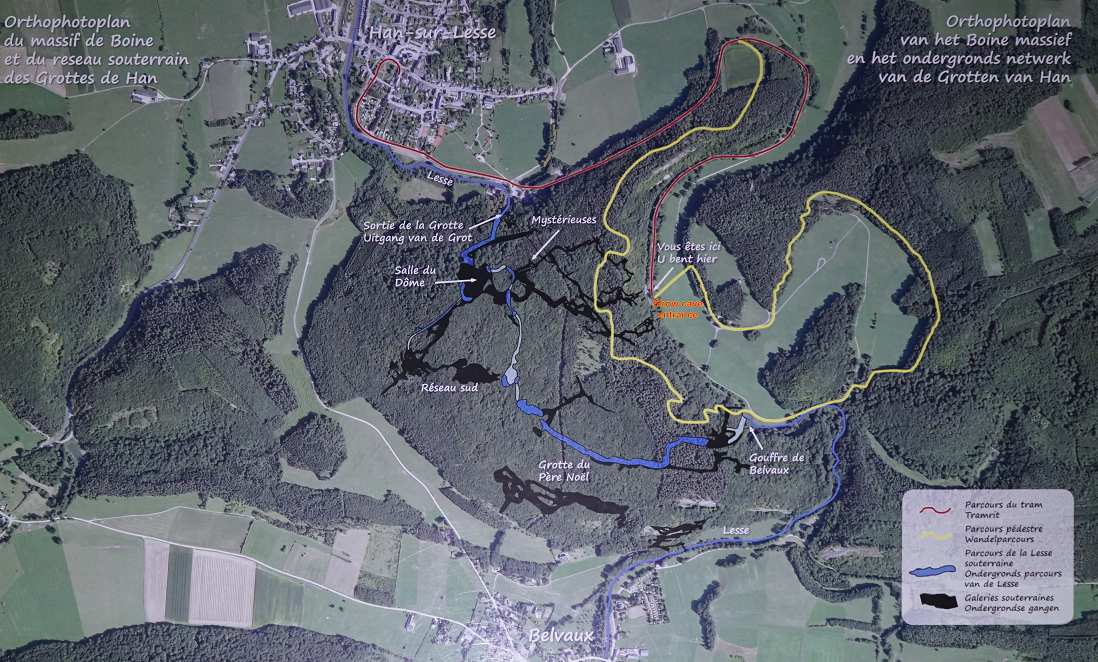
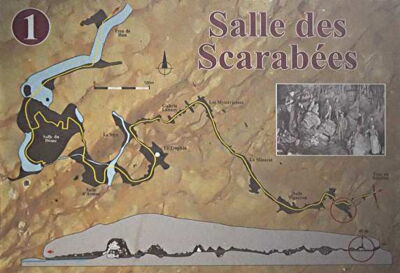
We then walked down the dry valley to the main show cave entrance, at the end of the train line from the village (the red line on the figure below).
This is known as the “Trou au Saltpêtre” entrance and has been the show cave’s main entrance since 1857. The figure above shows how the cave network allows the River Lesse to short-cut its original surface course. We were to follow the cave through the hill, to emerge at the point marked “Sortie” where the Lesse rises to re-join its old surface course. Our group was led by a very knowledgeable young guide.
As one progresses through the cave, there are informative maps at strategic points, showing one’s location within the cave and the name of the chamber, such as that at the Salle des Scarabées (‘Beetle Room’).
The massive speleothems just get better as you proceed through the cave.
The new LED lighting by Cave Lighting is certainly extremely well done. One particularly notices that the placement of lights is very deliberate, carefully highlighting the key features. Path lighting is also carefully placed, especially on stairs, to maximise safety. The only negative comments I could make about the lighting is (1) that there are places where lampenflora flourishes – probably because lights are left on for long periods and (2) in some places there are very obvious bundles of cables – perhaps this is old wiring, which is yet to be removed, or new which is yet to be concealed.
The River Lesse is a feature of the latter part of the tour, the walkway winding along its banks and crossing it by a large bridge. The lighting highlights the reflections. The Salle d’Armes is probably the second-largest chamber on the tour route, exceeded only by the next chamber, Salle du Dôme, which is even more difficult to photograph.
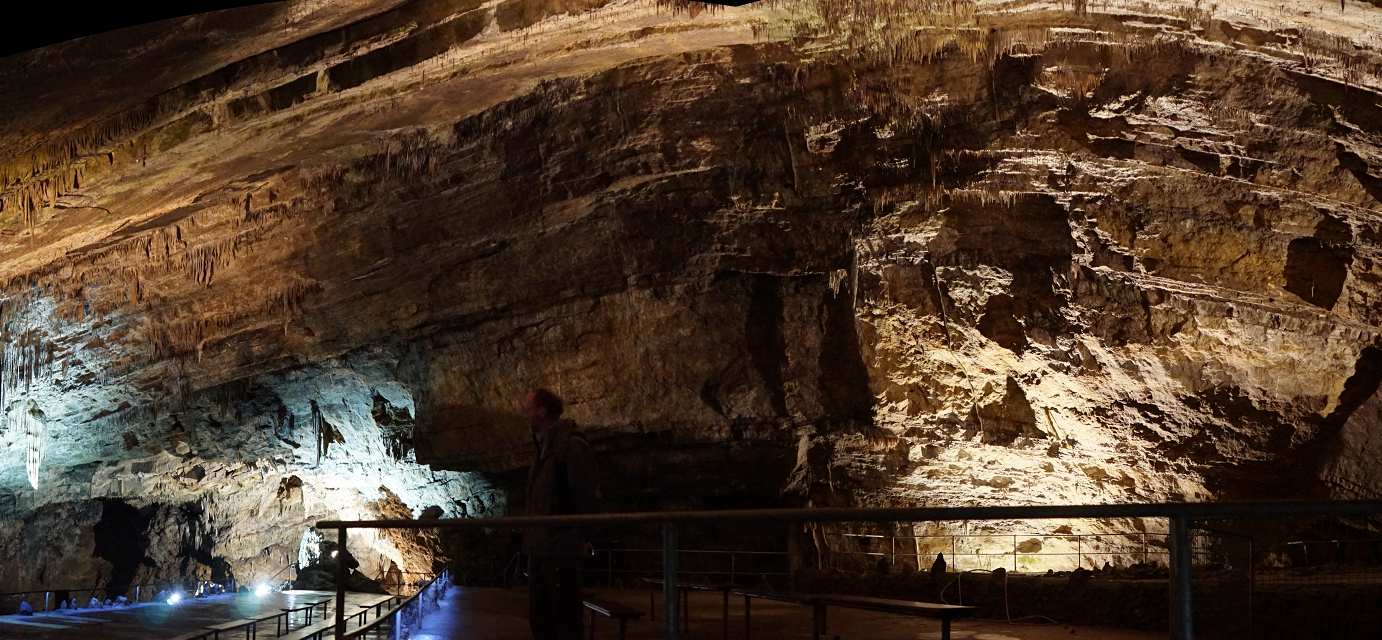
Leaving the huge Salle du Dôme, the tour path returns to the river passage where there are massive speleothems reflected in the water.
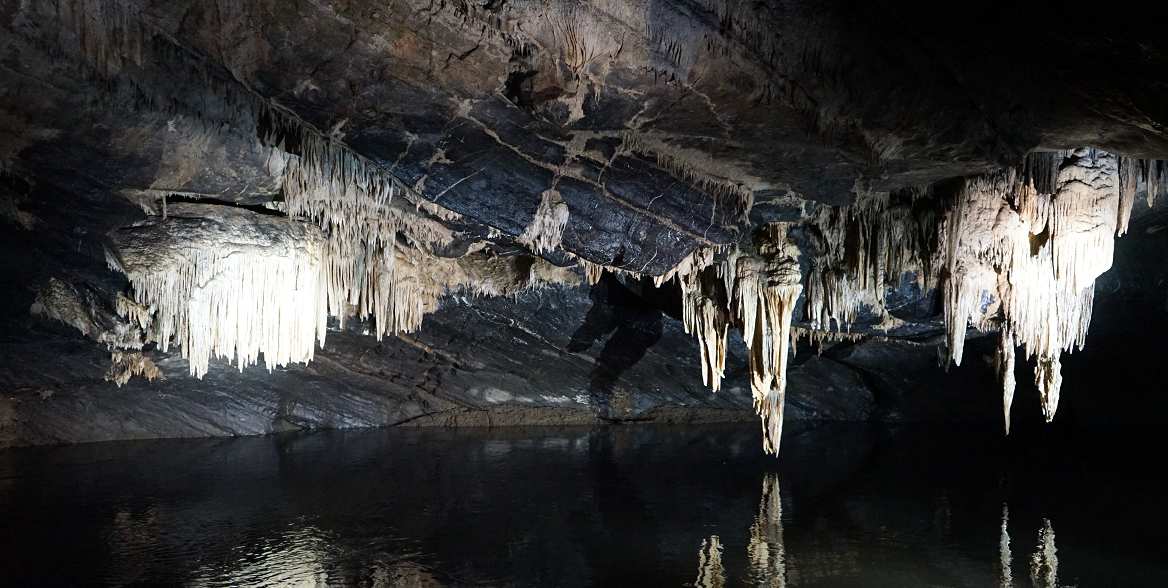
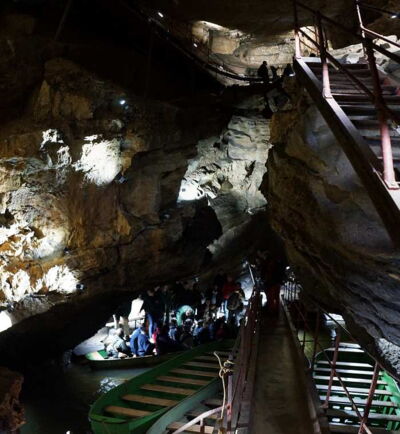
Eventually, at the conclusion of a memorable tour, one crosses the Lesse for the last time by a long bridge structure. Some of us couldn’t help thinking that the old way of exiting the cave (by punts, as shown in old publicity posters) might have been a lot more fun. No doubt the bridge simplifies the tour and allows a lot more tourists to be taken through the cave more quickly.
Next morning, back at the Grotte de Han museum theatre, Vladimir Vashkevich gave a presentation for Cave Lighting on technical aspects of the Grotte de Han relighting project. Cave Lighting’s initial involvement had been with tests in 2011; followed by concept development in 2012; and then progressive installation from late 2013 to late 2018. It had evidently been a huge undertaking.
This was followed by Jean-Pierre Bartholeyns of the IUS Dept. of Karst & Cave Protection on “Impact of new technologies and best practices in show cave management”; Brad Wuest, ISCA President, on ISCA’s “Recommended International Guidelines for the Development and Management of Show Caves”; and Peter Gazik of the Slovak Cave Administration on “Lighting of show caves in Slovakia – experience and perspectives”.
We then departed for an hour’s bus trip to Remouchamps where we waited as long again for lunch at the ironically named Au 1912 Restaurant. This was followed by a tour of the adjacent Grotte de Remouchamps. After the Grotte de Ham, I found the Grotte de Remouchamps a little disappointing, though it has its share of massive speleothems. The lighting was not as good as at Grotte de Han and, in places, the cave looked a bit tired and dirty. One positive that the Grotte de Remouchamps still enjoys is a boat ride – in fact it boasts the longest underground show cave boat trip in the world!
The event concluded with visits to two further Belgian show caves: Grotte de Lorette-Rochefort and Grottes de Hotton. At Grotte de Lorette, an older museum contains displays on cave science topics (hydrology, geology, seismology) and refers to an underground museum which seems not to be available for inspection. A sign explains that the cave is in the process of collapsing along an active fault (but gives no estimate of how long it might survive!).
Our tour was conducted by a local multi-lingual guide. The tour involves quite a steep descent (about 60m) on pathways that have not been refurbished in quite some time. The lighting could be described as “average”. The highlight of the tour, in the Salle du Sabbat, the highestroofed chamber in the system, was the release, by the guide, of a mini hot-air balloon which rose to the ceiling to the strains of some very pleasant classical music while a light show played on the walls. This was one of the most effective such presentations I have seen—mercifully not employing coloured lights.
Exiting this cave by a lower entrance, we then drove the short distance to the village of Hotton, where we visited our last cave of the trip, the Grottes de Hotton. The cave is evidently quite extensive (about 6 km long). A very energetic guide led us on our tour which descends quite steeply into a deep slot by a very substantial walkway. In this part of the cave we were ‘treated’ to a sound and light show, sadly in this case, utilising coloured lights. We exited the cave via a lift, emerging close to the entry building.
The workshop and field visits were undoubtedly a huge success and were greatly appreciated by all those who participated. Cave Lighting is to be congratulated for this initiative.
REFERENCES
IPSEN, Anne & MUCKE, Dieter 2011 Die Segeberger Höhle – eine welt im verborgenen. Fledermaus-Zentrum GmbH.
KEMPE, Stephan (Ed.) 1997 Welt voller geheimnisse: Höhlen (World full of secrets: Caves). HB Verlags und Vertriebs-Gesellschaft mbH: Hamburg.
KEMPE, Stephan & BAUER, Ingo 2017 3-D Imaging as a tool to understand speleogenetic processes [in] Moore, K. & White, S. (eds) Proc. 17th Int. Cong. of Speleology, Sydney. pp. 117-121.
KEMPE, Stephan, BAUER, Ingo & GLASER, Stefan 2017 Hypogene caves in Germany, geological and chemical background [in] Klimchouk, A. and others (eds) Hypogene Karst Regions and Caves of the World. Springer Int. Publishing: Switzerland pp. 329-347.
KNOLLE, Friedhart 2012 Es begann im Harz – Julius Riemer, Dr. Benno Wolf und die Höhlenforschung. Mitt. Arbeitsgem. Karstkde. Harz, 33 (1+2): 2-41.
VLADI, Firouz 2017 Gipsskarstlandschaft [Gypsum karst landscape] Hainholz-Beierstein. Förderverein Deutsches Gipsmuseum und Karstwanderweg e.V. 24 pp.
